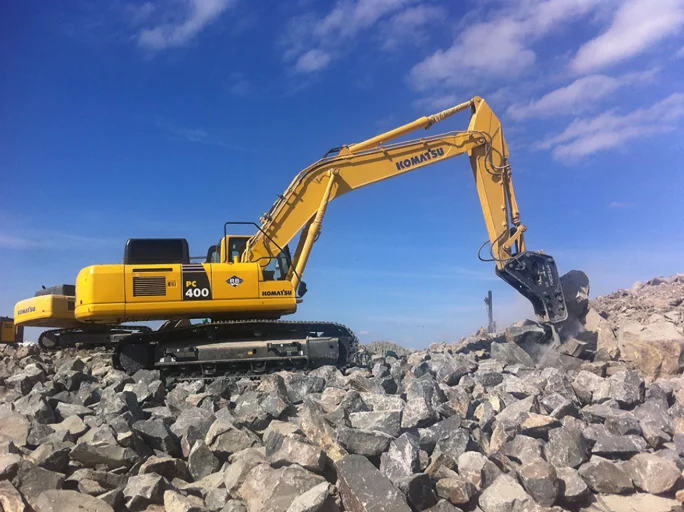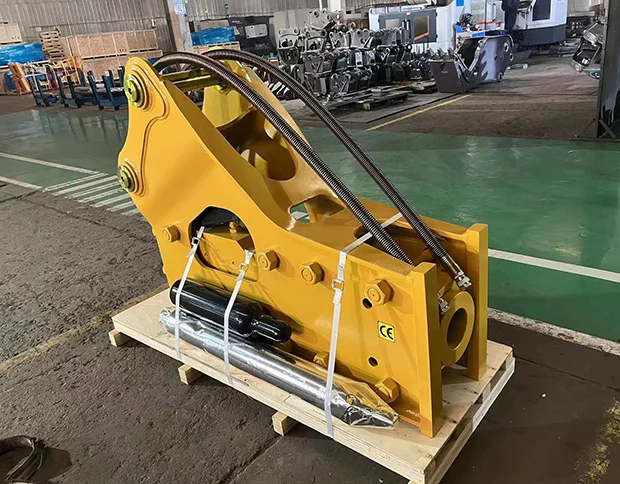How Hydraulic Rock Breakers Transform Mining and Quarry Work
Mining and quarrying have always been heavy, risky jobs. Picture a crew standing in front of a wall of granite, each block taller than a house. Traditional blasting was once the only way to handle such rock masses. But explosives come with a price: dust clouds, flying debris, vibration damage to nearby structures, not to mention the permits and red tape. That’s why hydraulic rock breakers—often called hydraulic rock hammers—have become the modern workhorse in this industry.
At Guangdong Kingho Technology, hydraulic breaker hammers are not just another attachment in a catalog. They’re the result of more than a decade of research, production, and hands-on feedback from operators. Kingho’s line covers side type, top type, and box type breakers, built for excavators from 4 to 50 tons. These breakers are out in quarries, mines, and demolition sites worldwide, quietly replacing a method that once shook the ground—literally.
Let’s walk through how these tools actually reshape daily work in mining and quarry operations.

How does a hydraulic rock breaker work in mining
Controlled energy delivery
A breaker takes hydraulic pressure from the excavator and channels it into rapid, hammer-like blows. The piston strikes the chisel, and the rock gives way piece by piece. It’s a simple concept, but the engineering behind it is refined. Kingho uses high-strength alloy steel and imported oil seals, making each strike consistent, even under extreme loads.
Efficiency compared to blasting
When you compare the two methods side by side, blasting is a sledgehammer while a breaker is more like a scalpel. With a breaker, you can target just the boulder blocking your haul road without disturbing the rest of the face. That precision reduces cleanup time, keeps haul trucks moving, and frankly keeps neighbors happier—no unexpected ground shaking.
Versatility across rock hardness
Operators sometimes wonder if breakers can really tackle granite or basalt. The answer is yes, provided the hammer is matched to the right excavator size. Kingho’s heavy-duty models, like their 165F and 185F series, are designed for exactly that. And when you’re working softer limestone or mixed soil layers, a smaller box-type breaker can handle the job while keeping noise down.
Why is a hydraulic breaker safer for quarry operations
Reduced flying debris
One of the constant risks with blasting is rock shrapnel. Even small chips can be dangerous at high velocity. Breakers chip away gradually, producing manageable fragments instead of uncontrolled projectiles.
Lower vibration impact
Quarries often operate near roads, rail lines, or even residential zones. Vibrations from explosives can crack nearby structures. A hydraulic hammer directs force into the rock without sending shockwaves far afield. Kingho reinforces this with dust-proof bearings and shock absorbers in their breaker housings.

Operator protection features
Let’s be honest: machines only matter if the operators feel safe. Kingho breakers are built with sealed housings and reinforced mounts, which means fewer sudden failures. And because attachments can be swapped quickly using quick hitches, operators spend less time in risky manual changeovers.
What advantages do breakers bring to productivity
Faster rock fragmentation
In practice, a breaker can turn a two-day blasting prep into half a day of continuous hammering. One quarry manager in Shandong reported his crew broke through a 500-ton boulder pile in a single shift with Kingho’s side-type hammer—no permits, no overnight delays.
Quick attachment change
Mining sites rarely work with just one tool. Breakers, buckets, shears, and grapples all rotate in and out. Kingho’s modular design means a skilled operator can switch from a breaker to a grapple in about 15 minutes. That’s less downtime, more uptime.
Lower downtime and maintenance
When machines stop, money burns. Breakdowns in harsh quarry environments are common, but Kingho combats this by using Hardox wear plates, honing tubes, and imported seals. The result is fewer unplanned halts. Some customers report running 1,000+ hours between major service intervals.
How do hydraulic breakers reduce operating costs
Less fuel consumption
Because breakers are precise, excavators spend less time idling and repositioning. A mid-sized operation can save hundreds of liters of diesel each month by replacing partial blasting with hydraulic hammers.
Extended tool longevity
Cheap chisels wear out quickly. Kingho manufactures its chisels and pistons from high-grade alloy steel, tested under extreme impact cycles. That means fewer replacements and less warehouse stock tied up in spares.
Minimal site preparation expenses
Skip the explosives team, skip the storage permits, skip the cordoned-off blasting zones. Breakers let you run continuously. Fewer interruptions mean less overhead.
Where are hydraulic rock hammers commonly used
Open-pit mining
From iron ore in Australia to limestone in Southeast Asia, open pits are prime territory for breaker hammers. They clear oversized rocks that crushers can’t handle and prep benches for drills.
Quarry block cutting
In stone quarries, precision matters. Breakers allow workers to split blocks for aggregate or decorative stone without wasting material. A box-type breaker is especially useful here—it’s quieter and less disruptive to the stone face.
Infrastructure excavation
It’s not just mines. Road crews use breakers for trenching hard ground, while tunneling projects rely on them to chip through mixed geology. Kingho’s catalog even shows breakers working alongside plate compactors and grapples on the same site.
How do Kingho breakers stand out in the market
Wide model range
Some suppliers only push one or two models. Kingho manufactures side type, top type, and box type breakers, adaptable for excavators from 4 to 50 tons. Whether you’re running a compact digger or a 36-ton unit, there’s a fit.
Proven certifications
International buyers look for credibility. Kingho holds CE, ISO9001, SGS, and BV certifications. That’s not just a stamp—it’s a comfort to contractors bidding on global projects.
Customer-focused design
Every mine is a little different. That’s why Kingho customizes brackets, mounting systems, and even flow settings. Their “one enterprise, one technology” R&D center in Guangdong exists precisely for this reason.
What future role will breakers play in mining efficiency
Automation integration
Smart excavators are no longer sci-fi. As digital hydraulics and sensors spread, breaker hammers will adjust impact force automatically, cutting human error.
Sustainable site practices
Green mining is a buzzword, yes, but reducing blasting genuinely cuts emissions and noise. Breakers fit naturally into that push. Less dust, fewer shockwaves, cleaner operations.
Global equipment partnerships
Kingho is expanding fast. With a new 57,000 m² factory and CNC lines, they’re scaling production for overseas demand. Expect to see more of their hammers shipped to Europe, the Middle East, and South America in the coming years.
Final Thoughts
Hydraulic rock breakers have done more than replace explosives. They’ve changed the culture of mining and quarrying: safer, steadier, and surprisingly more economical. For operators, it’s the difference between waiting for a blasting schedule and simply climbing into the cab and getting to work.
Kingho’s hydraulic breaker hammers embody that shift. Built tough, tested hard, and designed with both productivity and people in mind, they show what modern excavator attachments can achieve. Whether you’re running an open-pit mine or cutting stone for construction, the right breaker can literally move mountains—one strike at a time.
FAQs
Q1. What excavator sizes can Kingho hydraulic breakers fit?
They cover a wide range, from 4-ton compact excavators to 50-ton heavy machines, with side, top, and box type options.
Q2. How often should chisels be replaced on a breaker?
It depends on rock hardness and daily hours. Many Kingho users report 600–800 working hours per chisel under typical quarry conditions.
Q3. Can hydraulic breakers completely replace blasting?
Not entirely. Large-scale mass rock removal may still require explosives, but for most day-to-day mining and quarry work, breakers are now the tool of choice.

